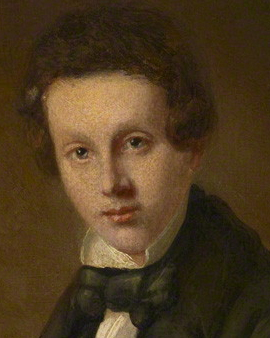The British artist Anthony Frederick Augustus Sandys was a painter of the Victorian age. Born the son of Anthony Sands, who was also a painter, the painter gave his son his first art lessons in addition to his birth name. The son took up art, changing his name to Frederick Sandys. Frederick early showed a marked talent for drawing, and his first steps were accompanied by great care in execution. Frederick was born in Norwich and attended the local schools. After graduating from the School of Art and Design in , Frederick was just seventeen years old.
The Norwich Art of Painters was the first art movement to form outside of the major artistic centers in England. The grouping of artists had their models in Dutch landscape painting of the Golden Age. The painters found their inspiration in the rural idyll of the Norwich area. Among the artists of the inner circle was John Crome, who mentored the young Frederick Sandys and helped him to continue his artistic path. Frederick Sandys devoted his first creative period to landscape painting, which was representative of the group of artists. A generous collector bought up almost all the paintings of the regional painters. Only a few works were shown in exhibitions and the painters achieved only regional notoriety. For Frederick Sandys, this was probably one of the reasons for breaking away from the group, without ever completely abandoning the connection. The good relationship with his teacher in particular accompanied Frederick throughout his successful career.
Frederick Sandys developed a style of drawing that was based on the art of the 15th century. His precision in elaboration was particularly evident in his illustrations and his portraits. In the kingdom, a new group of artists had made a name for themselves. The Pre-Raphaelites were looking for a way back to nature. Sandys had little contact with the group of artists at the beginning. This changed after an encounter with Dante Gabriel Charles Rossetti. Sandys became closer to the Pre-Raphaelites and is now considered the most important graphic artist of the group. The influence can be seen in the portraits Frederick Sandys produced. In addition to the bright and lively color scheme, Sandys reduces the images of the female figures to the ideal of beauty of the Victorian age. The women are beautiful, sporting long hair and evoking the characters that Shakespeare and Keats brought to life. They are portraits that could have stepped out of a world of myth and legend. Theodor Fontane once described the Pre-Raphaelites as painters who bring back to us the silver lining of art. Painters who wished to paint a reality that they themselves had created.
×





_-_(MeisterDrucke-1404250).jpg)
_-_(MeisterDrucke-1404250).jpg)
.jpg)
.jpg)
.jpg)
.jpg)
.jpg)
.jpg)
.jpg)
.jpg)
.jpg)
.jpg)
.jpg)
.jpg)
.jpg)
.jpg)
 - (MeisterDrucke-184142).jpg)
 - (MeisterDrucke-184142).jpg)
.jpg)
.jpg)
.jpg)
.jpg)
_-_(MeisterDrucke-261096).jpg)
_-_(MeisterDrucke-261096).jpg)
.jpg)
.jpg)
.jpg)
.jpg)
_-_(MeisterDrucke-393114).jpg)
_-_(MeisterDrucke-393114).jpg)
_-_(MeisterDrucke-319800).jpg)
_-_(MeisterDrucke-319800).jpg)
.jpg)
.jpg)
 1881 (pencil coloured chalk on pa - (MeisterDrucke-252490).jpg)
 1881 (pencil coloured chalk on pa - (MeisterDrucke-252490).jpg)
.jpg)
.jpg)
.jpg)
.jpg)
.jpg)
.jpg)
_-_(MeisterDrucke-559112).jpg)
_-_(MeisterDrucke-559112).jpg)
.jpg)
.jpg)
.jpg)
.jpg)
.jpg)
.jpg)
.jpg)
.jpg)
.jpg)
.jpg)
_-_(MeisterDrucke-902449).jpg)
_-_(MeisterDrucke-902449).jpg)
.jpg)
.jpg)
.jpg)
.jpg)
.jpg)
.jpg)
.jpg)
.jpg)
_-_(MeisterDrucke-314488).jpg)
_-_(MeisterDrucke-314488).jpg)
 - (MeisterDrucke-215909).jpg)
 - (MeisterDrucke-215909).jpg)
.jpg)
.jpg)
_-_(MeisterDrucke-1120605).jpg)
_-_(MeisterDrucke-1120605).jpg)
_-_(MeisterDrucke-1520254).jpg)
_-_(MeisterDrucke-1520254).jpg)
.jpg)
.jpg)
.jpg)
.jpg)
.jpg)
.jpg)
.jpg)
.jpg)
_Clarenceux_King_of_Arms_-_(MeisterDrucke-1631844).jpg)
_Clarenceux_King_of_Arms_-_(MeisterDrucke-1631844).jpg)
.jpg)
.jpg)
.jpg)
.jpg)
 - (MeisterDrucke-179720).jpg)
 - (MeisterDrucke-179720).jpg)
.jpg)
.jpg)
_-_(MeisterDrucke-1099830).jpg)
_-_(MeisterDrucke-1099830).jpg)
.jpg)
.jpg)
_-_(MeisterDrucke-278172).jpg)
_-_(MeisterDrucke-278172).jpg)
 - (MeisterDrucke-244781).jpg)
 - (MeisterDrucke-244781).jpg)
_c1871-73_(coloured_chalks_on_buff_paper)_-_(MeisterDrucke-902344).jpg)
_c1871-73_(coloured_chalks_on_buff_paper)_-_(MeisterDrucke-902344).jpg)
.jpg)
.jpg)
_-_(MeisterDrucke-1403378).jpg)
_-_(MeisterDrucke-1403378).jpg)
.jpg)
.jpg)
_-_(MeisterDrucke-1106795).jpg)
_-_(MeisterDrucke-1106795).jpg)
.jpg)
.jpg)
 - (MeisterDrucke-163323).jpg)
 - (MeisterDrucke-163323).jpg)
.jpg)
.jpg)
_-_(MeisterDrucke-1121646).jpg)
_-_(MeisterDrucke-1121646).jpg)
 - (MeisterDrucke-288975).jpg)
 - (MeisterDrucke-288975).jpg)
.jpg)
.jpg)
.jpg)
.jpg)
_(one_of_4)_-_(MeisterDrucke-553356).jpg)
_(one_of_4)_-_(MeisterDrucke-553356).jpg)
.jpg)
.jpg)
.jpg)
.jpg)
_-_(MeisterDrucke-1629883).jpg)
_-_(MeisterDrucke-1629883).jpg)
.jpg)
.jpg)
 - (MeisterDrucke-218054).jpg)
 - (MeisterDrucke-218054).jpg)
_-_(MeisterDrucke-1122798).jpg)
_-_(MeisterDrucke-1122798).jpg)
.jpg)
.jpg)
.jpg)
.jpg)
_-_(MeisterDrucke-1404663).jpg)
_-_(MeisterDrucke-1404663).jpg)
 - (MeisterDrucke-178681).jpg)
 - (MeisterDrucke-178681).jpg)
_-_(MeisterDrucke-1010248).jpg)
_-_(MeisterDrucke-1010248).jpg)
.jpg)
.jpg)
.jpg)
.jpg)
.jpg)
.jpg)
.jpg)
.jpg)
.jpg)
.jpg)
.jpg)
.jpg)
.jpg)
.jpg)
.jpg)
.jpg)
.jpg)
.jpg)
.jpg)
.jpg)
.jpg)
.jpg)
.jpg)
.jpg)
.jpg)
.jpg)






